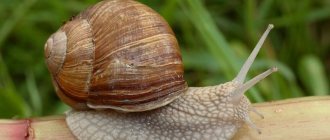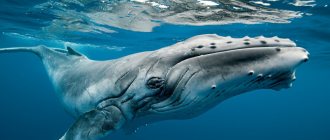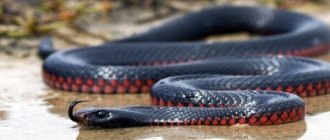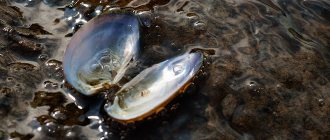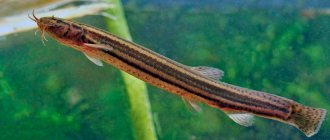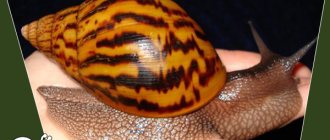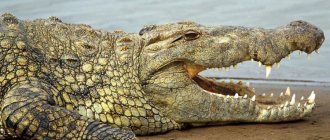Snails (Gastropoda lat.) - the largest group of gastropods. It is also one of the most diverse groups of animals, both in form, feeding habits, and habitat. There are more than 62,000 described living species of snails, and they make up about 80% of living molluscs. Estimates of total extant species range from 40,000 to 100,000, but there may even be as many as 150,000 species! There are approximately 13,000 genus names for both recently formed and fossil gastropods.
Description of the snail, structure, characteristics. What does a snail look like?
Snails or gastropods (Gastropoda) have figured prominently in paleobiological and biological research and have served scientists in numerous evolutionary, biomechanical, ecological, physiological, and behavioral studies.
Photo: PhotoJunket
Snails are characterized by having a single (often rolled) external shell and body, although gastropods with a vestigial shell or those that have lost it completely are called slugs. Since most gastropods have a shell, all representatives of the class are often called snails.
The body of a snail is made up of a head and a leg. It is also covered with a special fold - the mantle. Snails have a well-developed head with two head tentacles and eyes, which are primitively located near the outer bases of the tentacles. In some species, the eyes are located on short or longer eye stalks. The foot is usually quite large and is used for crawling. But it can be modified for snatching, jumping, swimming or clamping.
Let's look into the eyes of Achatina
In funny cartoons, Achatina eyes are drawn on long thin horns. Many breeders are of the opinion that the organs of vision of mollusks are located at the base of the antennae. But this is an erroneous opinion, and the time has come to figure out where Achatina’s eyes are?
It is known for sure that gastropods have poor vision and can only see objects at a distance of a few centimeters.
Mollusks perfectly distinguish between light and darkness and can react to bright flashes not only with their eyes, but with their whole body. Experienced owners leave part of the aquarium in the shade when installing lighting. With a constant stream of bright light, the hives will constantly bury themselves in the ground and hide from external stimuli.
In cartoons, the head of a snail is correctly depicted; the eyes of the mollusks are located on thin horns and are almost invisible. On the head of the Achatina snail, where the eyes are concentrated, thousands of light-sensitive cells are concentrated. They form the lens, which is attached to the optic nerves. Babies have a limited angle of vision, and moving eye barrels help them better see various interesting objects.
How many teeth does a snail have? And does she have teeth?
All snails have a special organ in their mouth called the radula. It combines the functions of teeth and tongue and consists of a cartilaginous plate on which cochlear teeth of various shapes are located in several rows.
Photo: Evan Butterfield
Snails that feed on plant foods have small teeth, while in predatory species they are larger, and their shape can be in the form of a hook or a pike. In total, a snail can have up to 25,000 teeth. Some poisonous snail species have teeth that have a cavity inside them. Toxins flow down it from a special gland and paralyze the victim.
snail shell
Typically, the snail shell resembles a spiral to which the retractor major muscle is attached. The uppermost part of the shell is formed from the larval shell (prototip). The shell is partially or completely lost in the juveniles or adults of some groups, with complete loss occurring in several groups of land and sea slugs.
Photo: Caleb Coppola
Externally, the snails are bilaterally symmetrical. Thanks to the shell, the internal organs of snails develop asymmetrically. Snail shells are very diverse in size and color; they can be completely smooth or have different growths and roughness. It all depends on the habitat and other vital habits of the snail.
Pet - Achatina
The structure of the Achatina snail, as well as its abilities, despite its apparent simplicity, have interesting features. Thus, they are characterized by long-term memory: Achatina can remember the location of food sources and return to them. Adults have a permanent place to rest; when the snail is moved to another place (within 30 meters), it will crawl back to its native, more familiar one. Young specimens are characterized by mobility and can cover long distances throughout the day; They also have the ability to migrate long distances.
Where do snails live?
Snails are extremely diverse in size, body and shell morphology, and occupy the widest range of ecological niches of any mollusk.
Photo: Denis Bondariev
They live in every possible place on Earth. Snails occupy all marine habitats, from the deepest ocean basins to the supralittoral, as well as freshwater and other inland water bodies, including salt lakes. They are also the only terrestrial molluscs, found in almost all habitats: from high mountains to deserts and rainforests, from the tropics to high latitudes.
What do snails eat?
The feeding habits of snails are extremely varied, although most species use the radula for feeding. They eat plants, carrion, grains, insects, worms and much more. Some types of snails simply graze on green grass, while others hunt for their prey.
Photo: Celeste Mookherjee
Most aquatic gastropods are benthic and primarily epifaunal, but a few are considered planktonic. For example, purple snails (Janthinidae) and sea lizards (Glaucus) drift along the ocean surface where they feed on floating siphonophores, while other species are active plankton-swimming predators.
Nutritional Features
Many people are interested in the care, nutrition and reproduction of snails. Gastropods feed on solid food and have herbivores and carnivorous mollusks. The type of food and diet depends on the species and habitat. For example, grape snails and Achatina eat fruits and vegetables, herbs, cereals, legumes, dandelion leaves, nettles, and grapes. However, mollusks do not refuse softened bread, mixed feed, eggs and minced meat.
How to feed snails. Marinades, pasta, citrus fruits, and smoked foods are prohibited. Food should be washed and preferably chopped before serving; food should be at room temperature. You also need water.
Just in case: although snails love to eat delicious food, dyes, flavors and spices, especially salt and sugar, should not be added to their food.
On a note:
- young individuals need to be provided with round-the-clock access to food;
- When feeding snails, it is important not to give them large portions of soft food - they can bury themselves in it and suffocate;
- If you habituate an animal to one type of food, it may subsequently refuse another food.
Predatory snails at home are fed either smaller snails or bloodworms, brine shrimp, and food containing protein, such as sinking catfish tablets.
Snail feeding in the natural environment
In the wild, the diet of mollusks also depends on the species and habitat. Herbivorous snails eat greens, grass, leaves, tree and plant bark, berries, fruits, and vegetables. If we talk about predators, their diet is also varied - from carrion, other mollusks and insects to worms and fish.
Snail breeding
Most snails have separate sexes, but some groups (mainly Heterobranchia) are hermaphrodites. Basal gastropods release their gametes into the water column, where they develop. The average number of snail eggs reaches 80-85 pieces. Their ripening lasts up to 21-28 days. Snail eggs can be of different colors - transparent, white, pink, green.
The first larval stage of a snail is usually a trochophore, which develops into a velger and then settles and metamorphoses to form a juvenile snail. While many marine species undergo larval development, there are also numerous marine taxa that undergo direct development, with this mode being the norm in freshwater and terrestrial snail groups. Reproduction of developing embryos is widespread in all snails.
Heterobranchia
Taxonomy of snails
There is still controversy regarding the phylogenetic position of some genera and groups of snails. Although the taxonomy discussed below is well supported in many modern analyses, some relationships remain somewhat unclear.
Neritopsina
The taxonomic group Neritopsina contains 6 families with marine, freshwater and terrestrial species. Widely varied gastropods, usually small to medium sized, that wrap their shells differently than other snails and do not have a central shell axis. The radula has many teeth in each row.
Vetigastropoda
The major taxonomic group Vetigastropoda is a diverse group that includes the families Fissurellidae, Haliotiidae, Pleurotomariidae and about 10 other families. They are all sea inhabitants that hide in a saucer-shaped shell. The shell is mostly mother-of-pearl and usually has a dome. The radula has many teeth in each row.
Caenogastropoda
Caenogastropoda is a very large, diverse group containing about 100 mostly marine families. Familiar groups include Littorinidae, Cypraeidae, Cerithiidae, Batellariidae and Potamididae, worm snails (Vermetidae), moon snails (Naticidae), apple snails (Ampullariidae), and a large, almost entirely marine group of about 20 families that are all carnivores. The shells of these snails are usually coiled. Members of the caenogastropoda make up about 60% of all living gastropods. Their shells are never mother-of-pearl. Apart from some members, the radula usually has only seven teeth in each row.
Heterobranchia
Heterobranchia is a subclass of gastropods (Gastropoda). The group is distinguished based on the structure of the gills and includes most modern species of gastropods. Early authors placed only marine species in Heterobranchia and considered this taxon as a transitional group between opisthobranchs and pulmonate mollusks. Their shells are never mother-of-pearl.
Patellogastropoda
Visiting almost any rocky environment you can find these wonderful gastropods from the group Patellogastropoda or true limpets. They carefully cling to rocks with their hard shells for protection, and they have many different behaviors related to their habitat and feeding. But true limpets are not limited to the tides, they can be found under the waves, in the deep sea, and there are even some species that live exclusively on driftwood that has sunk to the ocean floor.
They are all marine and many live in the tidal zone. The shell is mother-of-pearl in some taxa, and the porch is absent in adults. Their radula has multiple teeth in each row, some of which are strengthened by the inclusion of metallic ions such as iron.
Snail brains
In representatives of the Helix genus, scientists studied the action of command neurons responsible for behavior. These leading ganglia belong to a group of multimodal neurons connected by direct contacts with several systems.
In smart animals, neurons form many connections between parts of the brain
In another representative of terrestrial pulmonary mollusks, the African Achatina, giant neurons were discovered that are capable of performing the same functions that regulate certain areas of the cerebral cortex in humans. When studying the giant command neurons in Helix, scientists found that nerve connections are established not only with the muscles of the mantle, but also with the heart. This relationship allows a small number of cells to regulate the work that thousands of nerve structures perform in higher organisms. The efficiency of individual neurons increases, but the adaptability of the nervous system decreases.
Thus, due to the structural features of multimodal neurons, cochleas with a scattered nodal nervous system show complex behavior using several pairs of ganglia.
Unique experiments by Russian scientists on transplanting snail ganglia into the brains of laboratory rats will help in the treatment of diseases associated with the destruction of neurons in the human brain (Alzheimer’s and Parkinson’s diseases). For this purpose, scientists are transplanting gastropod ganglia into damaged areas of the central nervous system of rats. The most important concern during transplantation is preventing rejection of the transplanted cells, as the body gets rid of foreign proteins by triggering immune reactions. Snails have a weak immune system, so they are the easiest to conduct research with. Transplants taken from five-day-old individuals take root perfectly and quickly grow to 1.579 mm 2, that is, they increase several times.
Snails are donors of nervous tissue
Experimental animals with congenital epilepsy feel great; the duration of seizures decreases or convulsive activity completely disappears. The transplant releases physiologically active substances, the effect of which has not yet been fully studied. Now scientists are trying to determine how the transplanted ganglia affect the behavior of rats. In the future, these scientific studies suggest the creation of an effective technique for the treatment of severe disorders of human brain function. By studying the nervous processes in gastropods, we can understand the functioning of the human central nervous system. It’s like in mathematics, using a primitive calculator in calculations, you can learn how to work with a computer. A PC has a more complex mechanism than a calculator, but the principle of operation is the same. In the same way, in animals, by understanding the essence of the interaction of ganglia, one can learn how neurons operate in the human brain.
American biologists from California conducted an experiment on the transfer of long-term memory using the ganglia of the Aplysia mollusk or the sea hare. During the experiment, snails were taught to perceive a threat to life using a weak electric current. Gastropods responded to electrical stimulation by contracting their muscles. The experiment was repeated a day later and it was found that when struck, the muscles contracted faster by 50 seconds than in the control group of snails that did not undergo training. The research continued with the work of transplanting RNA nerve cells carrying memories of danger into new snails.
During the experiment, seven untrained individuals responded to external stimuli in the same way as experimental organisms, contracting their muscles in 40 seconds. During the development of the reflex, sensory neurons carrying certain RNAs act. The experiment confirmed scientists' assumptions that neurons are responsible for storing memories. In the future, it is planned to use similar RNAs to restore memory in people suffering from Alzheimer's disease.
Types of snails: marine, freshwater, land, gill and pulmonate
The most poisonous snail. The geographic cone snail (Conus geographus) is a native of the tropical and subtropical Indo-Pacific regions, found along the northern coasts of Australia. Their surrounding habitat includes live or fragmented coral reefs and sandy areas in tidal zones. They are less common in deeper waters.
The most poisonous snail Conus geographus
The geographic cone snail can kill 15 people with one bite. Symptoms include excruciating pain in the penetrating area, much worse than a bee sting. As the pain subsides, numbness soon sets in, followed by dizziness, slurred speech, and respiratory paralysis. Death may follow within half an hour after this, but such cases are rare. There is currently no known anti-venom; applied pressure to the wound, immobilization and artificial respiration (mouth-to-mouth resuscitation) are the only recommended treatment for the victim.
The smallest snail. The snail Angustopila dominikae is easy to miss, but several tiny shells were found among soil samples found beneath limestone rocks in China. They contained no snails, but the size of the shells indicates that the animals were less than 1 mm long, with the smallest specimen being only 0.86 mm long.
Angustopila dominikae - the smallest snail
The biggest snail. Australia is home to the world's largest snail, the Australian whelk (Syrinx aruanus). The record representative is a snail with a long shell of 91 cm and a weight of 18 kg. On average, the Australian whelk grows up to 70 cm long. They are predatory snails and feed on large live polychaete worms. Due to their popularity, large specimens are now rare, although juveniles often wash ashore after storms and cyclones in northern Australia.
The largest snail Syrinx aruanus
According to their habitat, all snails are divided into land, freshwater and marine, and according to the type of respiration - into pulmonary and gill snails.
Pulmonary snails. About 35,000 species are known, which are usually classified as pulmonate snails. The species characteristic is a functional lung, which was formed from the mantle cavity. To take air into the respiratory organs, they have a breathing hole located at the edge of the snail shell or in the front part of the muscular body. Typical representatives of this group are grape snails (Helix pomatia), coil snails (Planorbidae), Achatina (Achatina) and various slugs.
Helix pomatia
Gill snails. In species that live in the salty waters of seas and oceans, as well as in freshwater bodies of water, gills are located in the mantle cavity.
In addition to the organs that supply the snail’s body with oxygen, the mantle contains the exit ducts of the kidneys, which also includes the reproductive apparatus and excretory system. Among the known species of gill snails are Bithynia, lawn snails (Viviparidae), whelks (Buccinum) and many others. etc. Tags Snails
